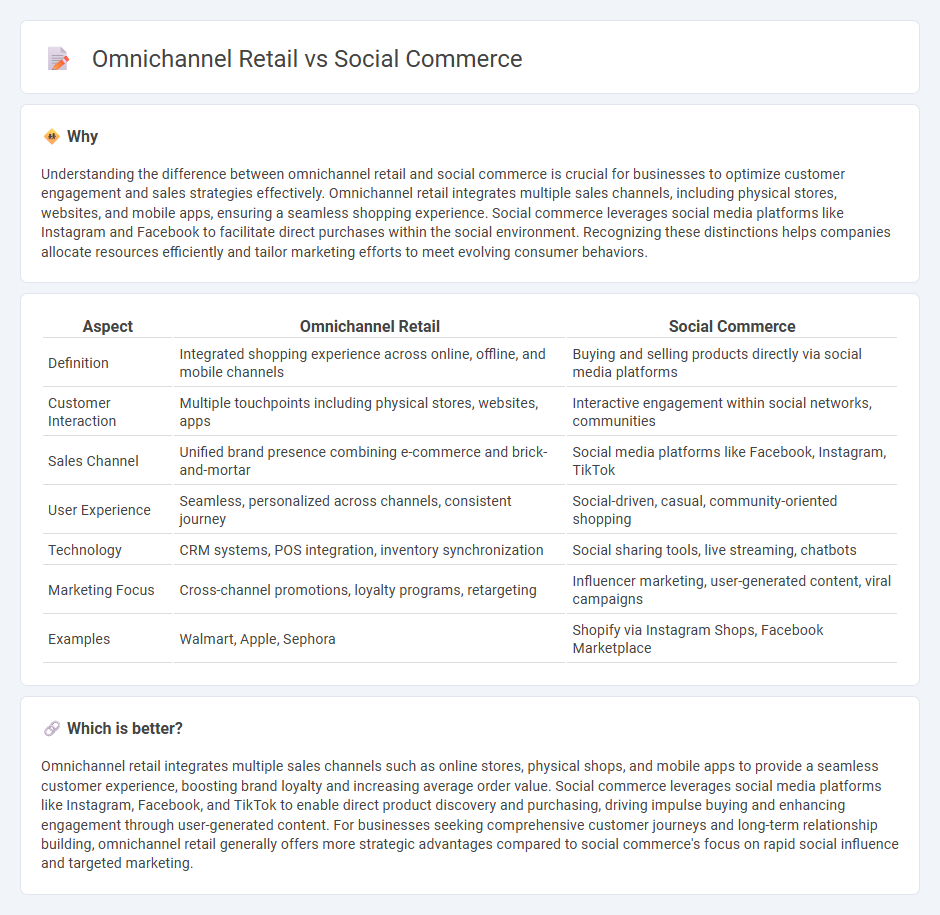
Omnichannel retail integrates multiple sales channels--physical stores, websites, mobile apps--to create a seamless shopping experience, boosting customer engagement and sales. Social commerce leverages social media platforms like Instagram and Facebook for direct shopping, combining user interaction with e-commerce convenience. Explore how these strategies transform modern retail and drive consumer behavior.
Why it is important
Understanding the difference between omnichannel retail and social commerce is crucial for businesses to optimize customer engagement and sales strategies effectively. Omnichannel retail integrates multiple sales channels, including physical stores, websites, and mobile apps, ensuring a seamless shopping experience. Social commerce leverages social media platforms like Instagram and Facebook to facilitate direct purchases within the social environment. Recognizing these distinctions helps companies allocate resources efficiently and tailor marketing efforts to meet evolving consumer behaviors.
Comparison Table
| Aspect | Omnichannel Retail | Social Commerce |
|---|---|---|
| Definition | Integrated shopping experience across online, offline, and mobile channels | Buying and selling products directly via social media platforms |
| Customer Interaction | Multiple touchpoints including physical stores, websites, apps | Interactive engagement within social networks, communities |
| Sales Channel | Unified brand presence combining e-commerce and brick-and-mortar | Social media platforms like Facebook, Instagram, TikTok |
| User Experience | Seamless, personalized across channels, consistent journey | Social-driven, casual, community-oriented shopping |
| Technology | CRM systems, POS integration, inventory synchronization | Social sharing tools, live streaming, chatbots |
| Marketing Focus | Cross-channel promotions, loyalty programs, retargeting | Influencer marketing, user-generated content, viral campaigns |
| Examples | Walmart, Apple, Sephora | Shopify via Instagram Shops, Facebook Marketplace |
Which is better?
Omnichannel retail integrates multiple sales channels such as online stores, physical shops, and mobile apps to provide a seamless customer experience, boosting brand loyalty and increasing average order value. Social commerce leverages social media platforms like Instagram, Facebook, and TikTok to enable direct product discovery and purchasing, driving impulse buying and enhancing engagement through user-generated content. For businesses seeking comprehensive customer journeys and long-term relationship building, omnichannel retail generally offers more strategic advantages compared to social commerce's focus on rapid social influence and targeted marketing.
Connection
Omnichannel retail integrates multiple sales channels, including physical stores, online platforms, and social media, to create a seamless shopping experience. Social commerce leverages social media networks as direct sales channels, enhancing customer engagement and facilitating instant purchases within these platforms. The connection lies in omnichannel strategies incorporating social commerce to unify customer journeys, drive conversions, and collect valuable data across all touchpoints.
Key Terms
Social Media Integration
Social commerce leverages social media platforms like Instagram and Facebook to enable seamless product discovery, shopping, and checkout within the apps, enhancing user engagement through interactive elements such as shoppable posts and live streams. Omnichannel retail integrates multiple sales channels, including physical stores, e-commerce sites, and social media, to provide a cohesive customer experience with consistent branding, inventory management, and personalized marketing across all touchpoints. Explore how leading brands optimize social media integration to boost sales and customer loyalty in both social commerce and omnichannel retail.
Unified Customer Experience
Social commerce integrates shopping directly within social media platforms, creating seamless engagement with personalized content and real-time customer interactions. Omnichannel retail offers a unified customer experience by synchronizing offline and online channels, enabling consistent brand messaging and smooth transitions between touchpoints. Explore how these strategies transform customer journeys and boost satisfaction for deeper market impact.
Sales Channel Diversification
Social commerce leverages platforms like Instagram and TikTok to directly engage customers and drive sales through interactive, influencer-driven content, optimizing conversion within social media ecosystems. Omnichannel retail integrates various sales channels including physical stores, e-commerce sites, mobile apps, and social media to provide a seamless and consistent customer experience across all touchpoints. Explore how combining these strategies can enhance your sales channel diversification for maximizing customer reach and revenue potential.
Source and External Links
Social commerce - Social commerce is the use of social networks to facilitate e-commerce transactions directly within social media platforms without leaving the site.
What is social commerce? - Social commerce leverages social apps like Facebook, TikTok, and Instagram with native shopping features allowing users to browse and buy products seamlessly while engaging with brands on social media.
Social Commerce 101: Examples, Platforms & Tips - Social commerce is the process of marketing, discovering, and purchasing products directly via social media profiles, creating a smooth and community-driven shopping experience.
 dowidth.com
dowidth.com